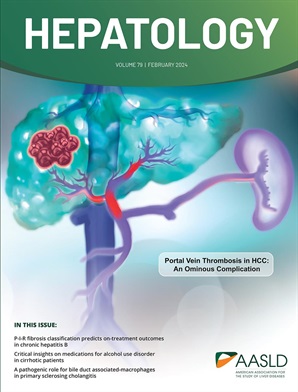ECM1 protects against liver steatosis through PCBP1-mediated iron homeostasis.
IF 15.8
1区 医学
Q1 GASTROENTEROLOGY & HEPATOLOGY
引用次数: 0
Abstract
BACKGROUND AND AIMS Extracellular matrix protein 1 (ECM1) is known to inhibit transforming growth factor β (TGF-β) signalling and hepatic stellate cells (HSCs) activation, thereby attenuating liver fibrosis. RNA-seq profiling of livers from wild-type (WT) and Ecm1-deficient mice revealed different enrichments in metabolic changes in fatty acid synthesis and inflammatory pathways, suggesting a regulatory role for ECM1 in liver steatosis. Here, we studied the role of ECM1 in metabolic dysfunction-associated steatotic liver disease (MASLD) pathogenesis and underlying mechanisms. APPROACH AND RESULTS Hepatic ECM1 expression was evaluated and found to be significantly reduced in liver samples from patients with metabolic dysfunction-associated steatohepatitis (MASH), and in four established MASH mouse models (HFD, MCD, HFHC, and ob/ob-/-). Although overexpression of ECM1 effectively blocked hepatic insulin resistance, steatosis, and inflammation, ECM1 ablation exacerbated diet-induced MASH progression. Mechanistically, ECM1 interacted with the K-Homology 3 (KH3) domain of poly rC binding protein 1 (PCBP1) to suppress iron overload, mitigating lipid peroxidation and consequently impeding metabolic dysfunction-associated steatohepatitis (MASH) advancement under metabolic stress. Re-expression of ECM1 and PCBP1 ameliorated liver disease progression. CONCLUSION Our study reveals that ECM1 is a critical regulator in MASH, modulating lipid peroxidation by maintaining PCBP1-mediated intracellular iron homeostasis. Targeting ECM1 to restore PCBP1-dependent iron homeostasis may offer a novel therapeutic avenue for MASH.ECM1通过pcbp1介导的铁稳态来防止肝脏脂肪变性。
已知细胞基质蛋白1 (ECM1)可抑制转化生长因子β (TGF-β)信号传导和肝星状细胞(hsc)活化,从而减轻肝纤维化。野生型(WT)和ECM1缺陷小鼠肝脏的RNA-seq分析显示,脂肪酸合成和炎症途径代谢变化的富集程度不同,表明ECM1在肝脏脂肪变性中具有调节作用。在这里,我们研究了ECM1在代谢功能障碍相关脂肪变性肝病(MASLD)发病机制和潜在机制中的作用。方法和结果:在代谢功能障碍相关脂肪性肝炎(MASH)患者的肝脏样本和四种已建立的MASH小鼠模型(HFD, MCD, HFHC和ob/ob-/-)中,肝脏ECM1表达被评估并发现显着降低。虽然ECM1的过表达有效地阻断了肝脏胰岛素抵抗、脂肪变性和炎症,但ECM1消融加剧了饮食诱导的MASH进展。在机制上,ECM1与poly rC binding protein 1 (PCBP1)的K-Homology 3 (KH3)结构域相互作用,抑制铁过载,减轻脂质过氧化,从而阻碍代谢应激下代谢功能障碍相关脂肪性肝炎(MASH)的进展。ECM1和PCBP1的重新表达改善了肝脏疾病的进展。我们的研究表明,ECM1在MASH中是一个关键的调节剂,通过维持pcbp1介导的细胞内铁稳态来调节脂质过氧化。靶向ECM1恢复pcbp1依赖的铁稳态可能为MASH提供新的治疗途径。
本文章由计算机程序翻译,如有差异,请以英文原文为准。
求助全文
约1分钟内获得全文
求助全文
来源期刊

Hepatology
医学-胃肠肝病学
CiteScore
27.50
自引率
3.70%
发文量
609
审稿时长
1 months
期刊介绍:
HEPATOLOGY is recognized as the leading publication in the field of liver disease. It features original, peer-reviewed articles covering various aspects of liver structure, function, and disease. The journal's distinguished Editorial Board carefully selects the best articles each month, focusing on topics including immunology, chronic hepatitis, viral hepatitis, cirrhosis, genetic and metabolic liver diseases, liver cancer, and drug metabolism.
 求助内容:
求助内容: 应助结果提醒方式:
应助结果提醒方式:


